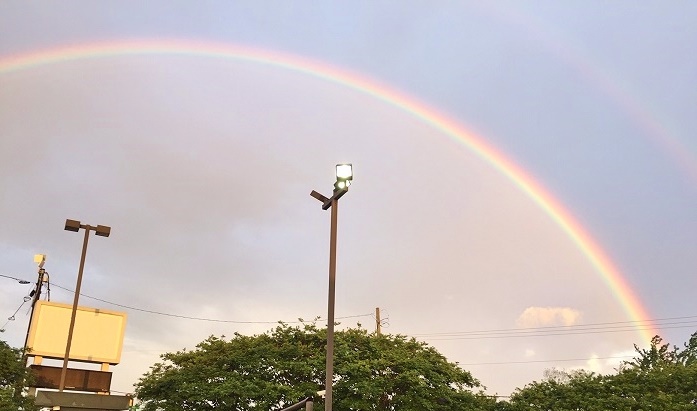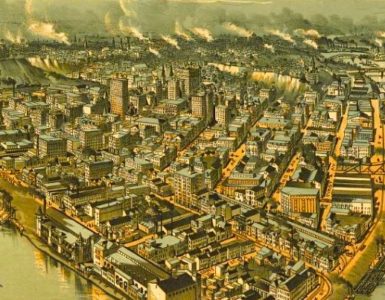The photograph of a rainbow was taken two Saturdays ago. It is unfortunate that the aperture of the lens was inadequate to show the entire arch which curved high in the sky and appeared to touch the earth at both ends. It was a perfect, but short lived, rainbow.
Rainbows are not miracles. The Oxford English Dictionary defines a rainbow as “An arch of colors visible in the sky, caused by the refraction and dispersion of the sun’s light by rain or other water droplets in the atmosphere.” When described scientifically the colorful bow loses some of its Judy Garland Somewhere Over the Rainbow appeal. Because rainbows tend to be large, colorful, and attention grabbing, their appearances over the years have induced onlookers all over the world to create fables and sayings such as the supposed pot of gold at the end of a rainbow, or the term “always chasing rainbows” which is used to describe individuals pursuing goals doomed to disaster. But there is more to rainbows than just science and sayings because God has given them theological significance.
The historical account of Noah, his family, the ark, and the preservation of animals to repopulate the world after the flood is common knowledge even among those who are unacquainted with the Bible. The word “antediluvian” means before the flood, as in Noah’s deluge, and it is used to describe someone who is old fashioned or behind the times. Common knowledge of the Noahic flood does not necessarily result in common acceptance of its historicity. Responses to the deluge fall within the spectrum of denying it ever happened at one end to accepting it for what it was at the other—a catastrophic event involving a household of God’s image bearers, a massive wooden ark, and animal life from all species. The purpose of the rains feeding the flood was to cleanse and renew the world because “the wickedness of man was great in the earth and every intention of the thoughts of his heart was only evil continually” (Gen. 6:5). As the water increased in depth it brought death and destruction to the wicked, but it also meant life for Noah’s household and the animals as they drifted afloat in the ark; the flood was the means of death for the evil, but the same flood was the means of life for Noah and the creation. When it was all said and done and the flood water receded, the Lord made a covenant with Noah, all mankind, and the creation.
8 Then God said to Noah and to his sons with him, 9 “Behold, I establish my covenant with you and your offspring after you, 10 and with every living creature that is with you, the birds, the livestock, and every beast of the earth with you, as many as came out of the ark; it is for every beast of the earth. 11 I establish my covenant with you, that never again shall all flesh be cut off by the waters of the flood, and never again shall there be a flood to destroy the earth.” 12 And God said, “This is the sign of the covenant that I make between me and you and every living creature that is with you, for all future generations: 13 I have set my bow in the cloud, and it shall be a sign of the covenant between me and the earth. 14 When I bring clouds over the earth and the bow is seen in the clouds, 15 I will remember my covenant that is between me and you and every living creature of all flesh. And the waters shall never again become a flood to destroy all flesh. 16 When the bow is in the clouds, I will see it and remember the everlasting covenant between God and every living creature of all flesh that is on the earth.” 17 God said to Noah, “This is the sign of the covenant that I have established between me and all flesh that is on the earth.” (Genesis 9:8-17)
The passage is replete with repetition. Repetition is used in Hebrew writing for emphasis, to strengthen communication of a point, and to drive a message home because it is the central concept of a passage. In this text there are eighteen occurrences of the name of God including pronouns; seven occurrences of the word covenant; and eight mentions of Noah or pronouns referring to him and/or his seed. God said he established his covenant not only with Noah and his household but also all creatures. The flood washed the wicked from the earth, but then the cleansed world was renewed by the ark’s animals propagating, flora sprouting and growing, and Noah’s family being fruitful and multiplying. With Adam’s fall, the creation was put in bondage through no fault of its own, but was instead the victim of man’s disregard of its welfare when he disobeyed God and brought the curse upon himself and the creation. The creation was renewed in hope of alleviated bondage as it anticipated the new heavens and the new earth (Romans 8:19ff). Just about in the center of this passage in both the English Standard Version (note the underline) quoted above and its Hebrew source are the words, “I have set my bow in the cloud.” Also underlined above are the words “sign of the covenant” which both precede and follow the clause regarding the bow. The rainbow is much more than an inspiration for fables, an idiom inducer, or a lovely item to sing about, it is a sign of God’s covenant with Noah. The simple rainbow that is sometimes seen spanning the sky on a rainy day is a reminder, a covenant sign. God’s bow in the clouds brings comfort to Christians and non-Christians alike regarding the promise that the earth will not be destroyed by a flood again, but for the non-Christian the rainbow is also a reminder of the Creator of heaven and earth to whom worship is owed. As the waters of the flood fulfilled the two-fold purpose of delivering Noah’s household afloat in the ark while destroying the wicked, so God’s bow spanning heaven brings comfort to his people redemptively while convicting the unrighteous as they go about their lives apart from the saving grace of Christ. Rainbows should be seen as evangelistic tools; God’s bow in the clouds leads to the cross, death, and resurrection of Christ.
There is a pot full of gold at the end of the rainbow but the content is not element 79 of the periodic table, rather, it is God’s Covenant of Grace and the golden redemption from sin purchased by Christ and received by faith.
BARRY WAUGH
Notes—The underlined portions of Genesis 9:8-17 appears to me to be in chiasm, which is another technique Hebrew composition used to provide emphasis. Material read for this post includes John Calvin’s commentary and sermon on the Genesis passage, Palmer Robertson’s Christ of the Covenants, Boice on Genesis, and Derek Kidner on Genesis.





